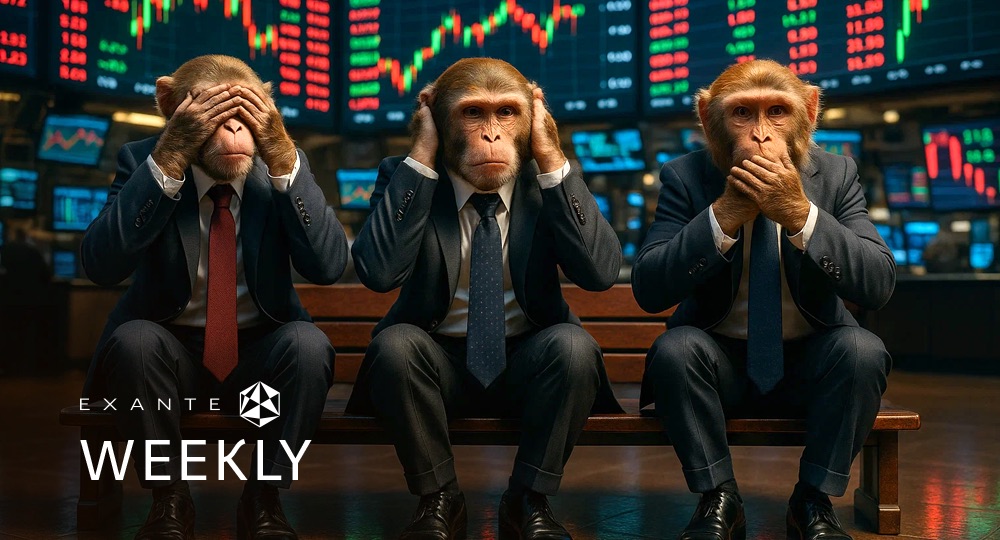Key data to move markets today
China: Industrial Production and Retail Sales.
US: NY Empire State Manufacturing Index, Retail Sales, Industrial Production, Michigan Consumer Inflation Expectations Index, and UoM 1-year and 5-year Consumer Inflation Expectations.
Global: Trump - Putin meeting.
US Stock Indices
Dow Jones Industrial Average -0.02%.
Nasdaq 100 -0.07%.
S&P 500 +0.03%, with 4 of the 11 sectors of the S&P 500 up.
Stocks closed Thursday with minimal change. They largely managed to recover some earlier losses driven by a surge in factory-gate inflation, which cast uncertainty on the future of interest rates. The Dow, after an earlier drop of more than 200 points, finished down by 11 points.
The producer-price index revealed a stronger-than-expected 0.9% increase in July, marking the largest monthly rise in over three years.
According to LSEG I/B/E/S data, y/o/y earnings growth for the Russell 2000 in Q2 is projected to be +67.3%. This number jumps to 88.4% when excluding the Energy sector. Of the 1,620 companies in the Russell 2000 that have reported earnings to date for Q2 2025, 62.1% have reported earnings above analyst estimates, with 63.6% of companies reporting revenues exceeding analyst expectations. The y/o/y revenue growth is projected to be 2.4% in Q2, increasing to 3.1% when excluding the Energy sector.
The Consumer Staples sector, at 72%, is the sector with most companies reporting above estimates, while Technology with a surprise factor of 50.8%, is the sector that’s beaten earnings expectations by the highest surprise factor. Within Materials, 47% of companies have reported below estimates, and the Communication Services is the sector with the lowest surprise factor at -111.0%. The Russell 2000 surprise factor is 8.6%. The forward four-quarter price-to-earnings ratio (P/E) for the Russell 2000 sits at 26.8x.
In corporate news, Deere & Co., the world's leading manufacturer of farm machinery, has revised its annual earnings forecast downward. This adjustment is due to lower grain prices, which are prompting farmers to reduce their spending on new equipment.
Peloton Interactive is preparing for its most significant product overhaul in years. The company aims to revitalise sales by introducing updated hardware, new accessories, and integrating artificial intelligence into its offerings.
Eli Lilly & Co. is increasing the list price of its obesity treatment in the UK by up to 170%. This decision comes as the pharmaceutical industry faces pressure from US President Donald Trump to raise drug prices in Europe in order to lower costs for American consumers.
Costco Wholesale announced it will not offer the abortion pill mifepristone at its more than 500 pharmacy locations. This decision was praised by a coalition of faith-based activists who had encouraged the retailer to refrain from selling the medication.
Southwest Airlines has sold its renewable fuels division to Conestoga Energy. This move signals the airline's decision to scale back its climate-focused initiatives, following years of limited progress within the industry.
S&P 500 Best performing sector
Financials +0.55%, with Charles Schwab +2.29%, Northern Trust +2.00%, and Wells Fargo & Co +1.95%.
S&P 500 Worst performing sector
Industrials -0.88%, with Deere & Co. -6.76%, Builders FirstSource -4.33%, and Snap-On -2.72%.
Mega Caps
Alphabet +0.39%, Amazon +2.87%, Apple -0.24%, Meta Platforms +0.26%, Microsoft +0.36%, Nvidia +0.26%, and Tesla -1.08%.
Information Technology
Best performer: Intel +7.38%.
Worst performer: Enphase Energy -5.84%.
Materials and Mining
Best performer: Dow +1.96%.
Worst performer: Amcor -11.87%.
European Stock Indicest
CAC 40 +0.84%.
DAX +0.79%.
FTSE 100 +0.13%.
Corporate Earnings Reports
Posted on Thursday, 14th August
- Deere & Co. quarterly revenue -9.0% to $10.357 bn vs. $10.351 bn estimate.
EPS at $4.75 vs. $4.78 estimate.
John May, Chairman and CEO, said, “As we navigate the current environment, our customers remain our top priority. I’m incredibly proud of our team’s execution this quarter, delivering exceptional performance despite challenging market dynamics. Their dedication and hard work have been instrumental in ensuring our customers continue to receive the high-quality service and products they expect from John Deere.” — see report.
- JD.com quarterly revenue +16.1% to $41.808 bn vs. $40.275 bn estimate.
EPS at $1.17 vs. $0.99 estimate.
Sandy Xu, CEO, said, “In the second quarter, we saw robust growth in user traffic, quarterly active customers, and user shopping frequency on JD’s platform, driven by sustained momentum across both our core JD Retail business and New Businesses including JD Food Delivery. JD Retail delivered a strong 20.6% year-on-year revenue growth during the quarter, with operating margin reaching 4.5%, a historic high across all promotion quarters. JD Food Delivery also made healthy progress during the quarter in metrics such as order volume growth, merchant base expansion, full-time rider recruitment, and more importantly, synergies with retail and other existing businesses of JD, having successfully achieved our initial strategic goals. Looking ahead, we are confident that our core retail business will remain a solid cornerstone of our operations as we continue to focus on delivering the best user experience, lowering costs, and improving efficiency. At the same time, we will continue to invest in new growth areas in alignment with our long-term strategic roadmap.” — see report.
- Applied Materials quarterly revenue +7.7% to $7.302 bn vs. $7.222 bn estimate.
EPS at $2.48 vs. $2.36 estimate.
Gary Dickerson, President and CEO, said, “Applied Materials delivered record performance in our third fiscal quarter, and we are on track to deliver our sixth consecutive year of revenue growth in fiscal 2025. We are currently operating in a dynamic macroeconomic and policy environment, which is creating increased uncertainty and lower visibility in the near term, including for our China business. Despite this, we remain very confident in the longer-term growth opportunities for the semiconductor industry and Applied Materials.” — see report.
Commodities
Gold spot -0.53% to $3,336.56 an ounce.
Silver spot -1.47% to $37.91 an ounce.
West Texas Intermediate +1.90% to $63.93 a barrel.
Brent crude +1.64% to $66.84 a barrel.
Gold prices declined on Thursday, influenced by stronger-than-expected US economic data. The release of hotter-than-anticipated inflation figures and a decrease in jobless claims bolstered the US dollar and Treasury yields.
Spot gold fell by -0.53% to $3,336.56 per ounce. The US dollar was +0.40% from its two-week low, making gold less appealing to international buyers.
On Thursday, oil prices reached a one-week high following a warning from the US President of ‘severe consequences’ should his discussions today in Alaska with Russian President Vladimir Putin concerning Ukraine prove unsuccessful.
Brent crude futures increased by $1.08, or +1.64%, settling at $66.84 per barrel. The price gains led Brent to its highest closing value since 6th August. WTI crude rose by $1.19, or +1.90%, to settle at $63.93.
On Tuesday, Brent and WTI crude had closed at their lowest prices since 5th June and 2nd June, respectively. The decline earlier this week was partly attributed to bearish inventory and supply data forecasts from the US Energy Information Administration and the International Energy Agency.
The ongoing conflict and potential for sanctions against Russia are key factors influencing the market. As the world's second-largest producer of crude in 2024, behind the US, any agreement that could ease sanctions on Moscow would likely increase the amount of Russian oil available for export. Conversely, the US President has threatened to enact secondary tariffs on major buyers of Russian crude, such as China and India, if Russia's actions in Ukraine persist.
Note: As of 5 pm EDT 14 August 2025
Currencies
EUR -0.47% to $1.1649.
GBP -0.28% to $1.3527.
Bitcoin -3.94% to $117,973.31.
Ethereum -5.84% to $4,482.03.
The US dollar gained against most major currency pairs on Thursday, following the release of US producer prices (PPI) data. PPI increased more than anticipated in July, driven by a significant rise in the cost of services and goods. This led to speculation of broader inflationary in the coming months.
St Louis Fed President Alberto Musalem stated on Thursday that a 50 bps interest rate cut at the Fed's September meeting is not justified given the current economic climate. Musalem noted that the US economy is nearing full employment, inflation remains above the Fed's target, and businesses are still adjusting to recent import tax increases.
The dollar index rose by +0.40% to 98.20. The euro weakened by -0.47% against the dollar, falling to $1.1649, and the British pound eased by -0.28% to $1.3527.
Earlier in the session, the US dollar had weakened against the Japanese yen after US Treasury Secretary Bessent suggested the need for another BoJ rate hike. However, the dollar closed +0.26% higher at ¥147.76.
Fixed Income
US 10-year Treasury +5.0 basis points to 4.290%.
German 10-year bund +3.2 basis points to 2.715%.
UK 10-year gilt +5.2 basis points to 4.647%.
US Treasury yields advanced on Thursday following the release of higher than expected July producer price data which reduced the likelihood of the Fed implementing a rate cut larger than 25 bps at its September meeting.
It had been suggested that a more substantial rate cut could be possible if August's jobs report was weak. However, July’s PPI figure made this outcome less probable.
According to the Labor Department's Bureau of Labor Statistics, the Producer Price Index (PPI) for final demand surged by 0.9% last month, a significant increase from its unchanged status in June and well above the 0.2% rise that economists had forecast.
This news prompted a rise in Treasury yields across the curve. The yield on the 2-year Treasury note, a key indicator of interest rate expectations, was +4.8 bps to 3.741%. This reversed an earlier fall, which had seen the yield decline to 3.655%, its lowest point since 1st May. The yield on 10-year notes also climbed, rising +5.0 bps to 4.290%. The 30-year yield was +4.5 bps, reaching 4.873%.
In addition, the Treasury Department announced its plans for upcoming auctions. It will sell $16 billion in 20-year bonds next week, alongside $8 billion in 30-year Treasury Inflation-Protected Securities (TIPS).
Fed funds futures traders are now pricing in a 92.1% probability of a rate cut in September, slightly up from 91.9% last week and down from 94.3% Wednesday, according to CME Group's FedWatch Tool. Traders are currently anticipating 56.9 bps of cuts by year-end, lower than the 59.4 bps expected last week.
Across the Atlantic, eurozone government bond yields increased on Thursday. This movement occurred as money market futures began to price in an ECB deposit rate of 1.90% by the end of 2026, a slight decrease from the current 2.00%.
Yields on German government bonds rose across the maturity spectrum. The two-year yield, which is particularly sensitive to shifts in monetary policy, was +1.3 bps to 1.943%, reversing Wednesday’s 3.6 bps decline. The 10-year German yield was +3.2 bps to 2.715%, following a 6.4 bps drop on Wednesday. Furthermore, the 30-year yield was +3.9 bps to 3.266%.
The Italian 10-year bond yield was +2.6 bps to 3.485%. This tightened the spread between Italian and German 10-year yields to 77.0 bps, marking its tightest level since at least 2011.
The yield spread between Italian and French 10-year bonds also narrowed to approximately 11.6 bps. This narrowing reflects growing investor concerns about France's fiscal outlook, particularly after the government announced a 2026 budget plan in July that includes nearly €44 billion in spending cuts. These cuts are expected to face opposition from Socialist lawmakers when parliament reconvenes.
Looking ahead, investors are closely monitoring today’s Alaska summit between US President Trump and Russian President Putin. Analysts suggest that a potential ceasefire in Ukraine resulting from these talks could bolster riskier assets and put downward pressure on government bond prices.
Note: As of 5 pm EDT 14 August 2025
Global Macro Updates
July PPI report hotter, jobless lower than consensus. In July, the Producer Price Index (PPI) experienced a notable increase, rising by 0.9% m/o/m. This figure significantly exceeded the consensus forecast of a 0.2% rise and marked the sharpest increase since March 2022. The annualised headline PPI also accelerated to 3.3%, surpassing the 2.4% consensus and the 2.4% reading from June.
The Core PPI, which excludes food and energy prices, also rose by 0.9% m/o/m, exceeding the 0.2% consensus and June's unchanged reading. On an annualised basis, the core PPI increased to 3.7%, considerably higher than the 2.9% consensus and the 2.6% recorded in June.
The report highlights that more than 75% of the July increase was driven by the index for final demand services, which advanced by 1.1%—its largest increase since March 2022. This gain was primarily attributed to an increase in margins for machinery and equipment wholesaling. Prices for final demand goods also rose by 0.7%, the largest jump since January 2025, largely due to a 1.4% increase in the index for final demand foods.
In other economic news, initial jobless claims for the week were 224,000, lower than the 230,000 consensus and down from the prior week's 227,000. Continuing claims also fell to 1,953,000, which was below the 1,960,000 consensus and down from the previous week's 1,968,000.
Low expectations for a breakthrough in Alaska. President Trump and President Putin are scheduled to meet today in Alaska to discuss a potential ceasefire in Ukraine. However, expectations for a significant breakthrough remain low, as the White House has tempered prospects of a formal agreement, characterising the meeting instead as a ‘listening exercise.’
Ukrainian President Zelensky has reaffirmed his position that Ukraine will not cede the Donbas region to Russia, stating that doing so would provide Moscow with a strategic base for future offensives. Furthermore, Ukraine's constitution mandates parliamentary approval for any territorial concessions, and there is currently no domestic political support for such a measure.
Market analysts are monitoring the summit for potential impacts on oil prices. Nevertheless, experts caution that a lifting of sanctions on Russia is improbable. This is due to the EU's control over the majority of these measures and its firm opposition to any land concessions by Ukraine.
San Francisco Fed’s Daly concerned about projecting unnecessary urgency. In an interview with The Wall Street Journal, San Francisco Fed President Mary Daly, a non-voting member of the FOMC, expressed her opposition to a 50 bps interest rate cut. Citing the current strength of the labour market, she stated that such a significant cut would send an ‘unwarranted signal of urgency.’
Daly reiterated her belief that the current monetary policy is likely to be too restrictive for where the economy is headed and that rate cuts may be justified. However, she emphasised a preference for a gradual move toward a neutral policy stance over the next year, rather than a rapid ‘catch-up’ approach. She specifically noted, "Fifty sounds, to me, like we see an urgent—I'm worried it would send off an urgency signal that I don't feel about the strength of the labour market. I just don’t see that. I don't see the need to catch up."
These comments follow remarks from Treasury Secretary Bessent, who suggested the Fed should begin lowering rates by 150 - 175 bps from current levels, starting with a 50 bps cut in September. Bessent also speculated that the Fed might have already initiated cuts had they been aware of upcoming large downward revisions to payroll data.
Daly's position is echoed by former St. Louis Fed President James Bullard, who is reportedly being considered for the Fed Chair position. On Wednesday Bullard stated in a Bloomberg news interview that a 50 bps cut ‘sounds panicky.’
While every effort has been made to verify the accuracy of this information, EXT Ltd. (hereafter known as “EXANTE”) cannot accept any responsibility or liability for reliance by any person on this publication or any of the information, opinions, or conclusions contained in this publication. The findings and views expressed in this publication do not necessarily reflect the views of EXANTE. Any action taken upon the information contained in this publication is strictly at your own risk. EXANTE will not be liable for any loss or damage in connection with this publication.
Este artigo é-lhe fornecido apenas para fins informativos e não deve ser considerado como uma oferta ou solicitação de uma proposta para compra ou venda de quaisquer investimentos ou serviços relacionados que possam ser aqui referenciados.






